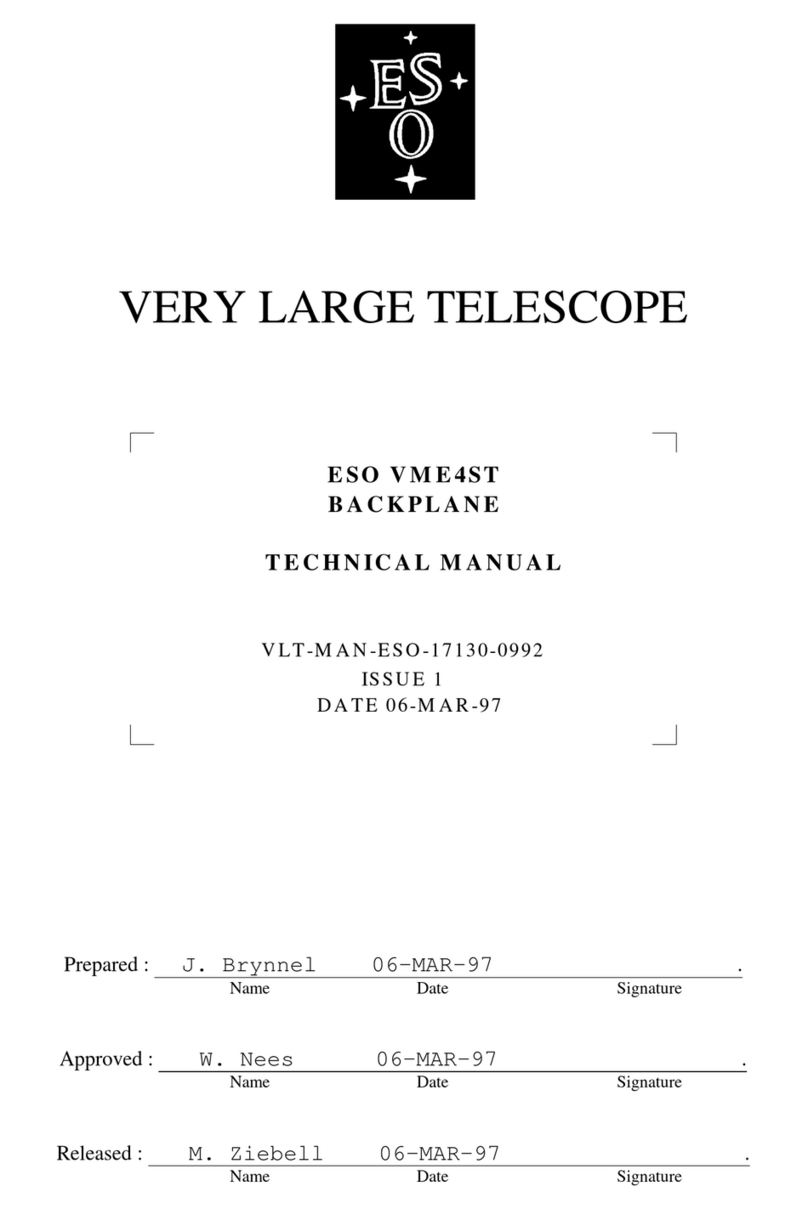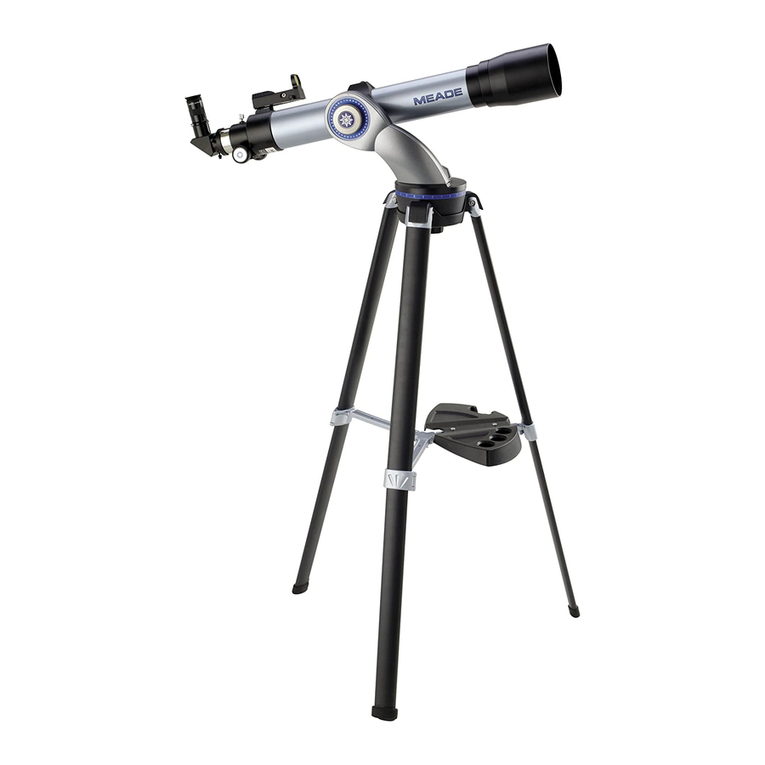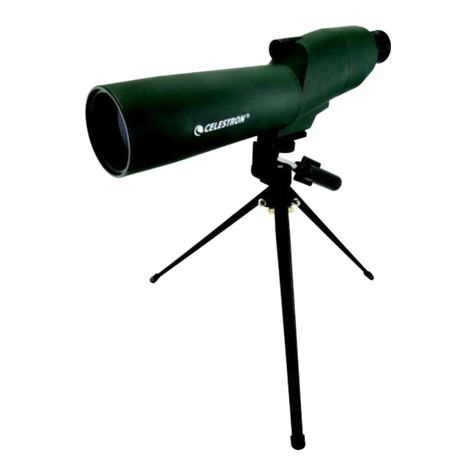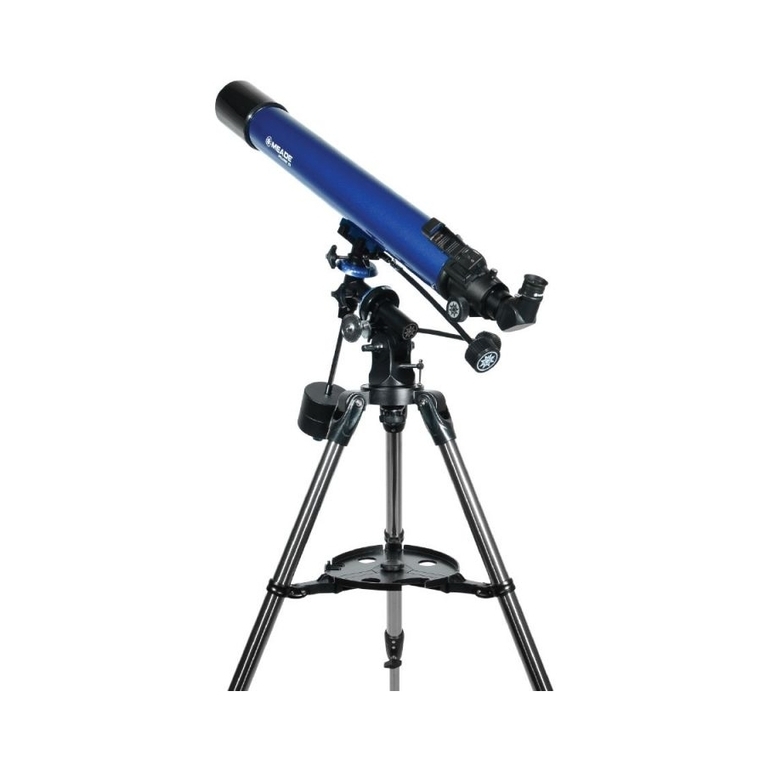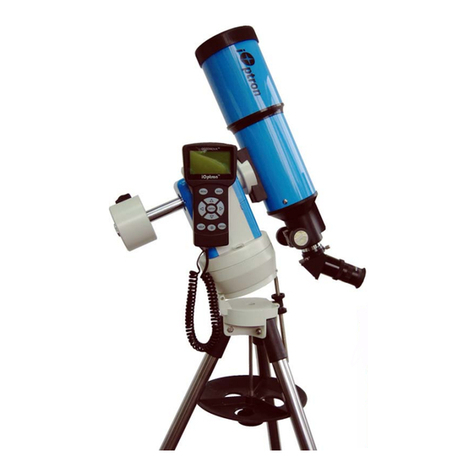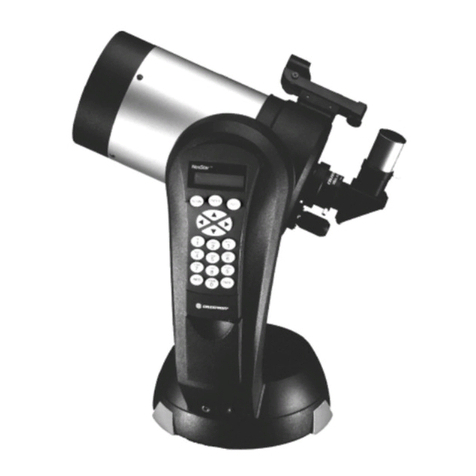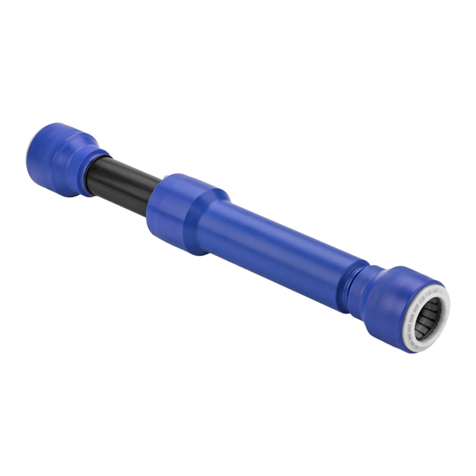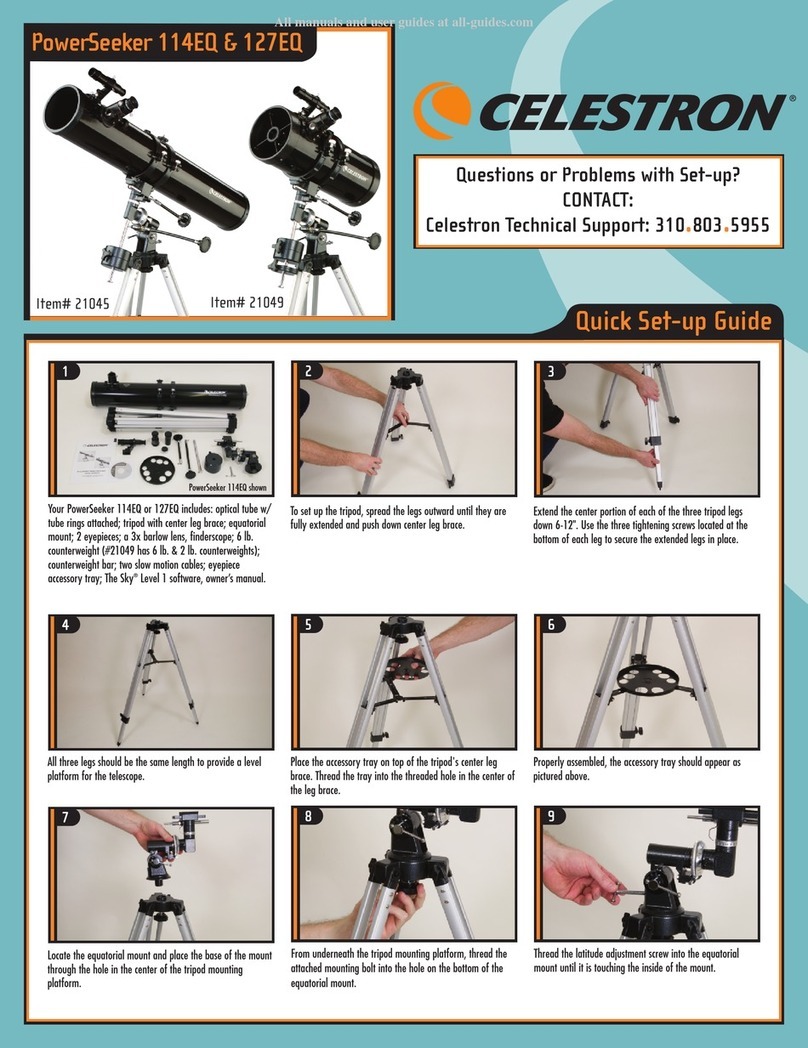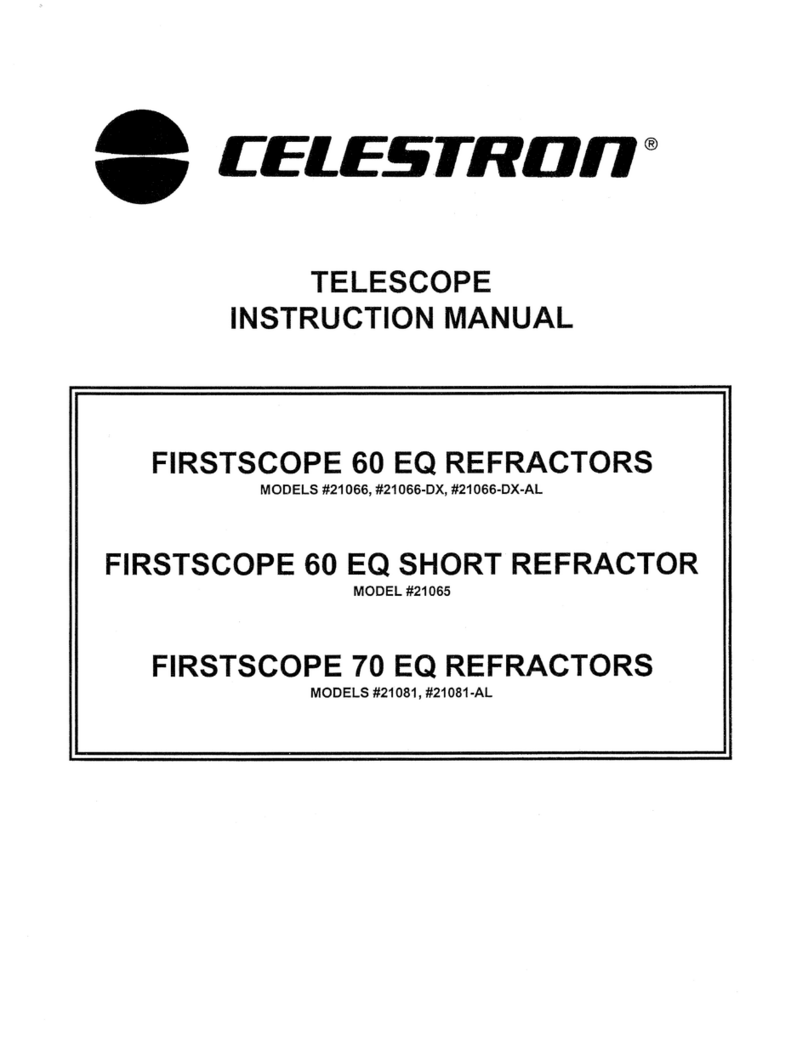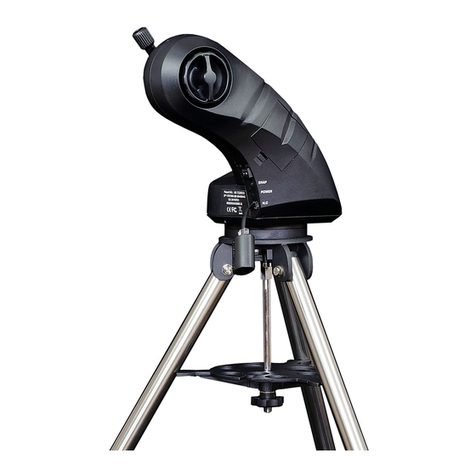Stellarvue SVX130T PREMIER User manual

STELLARVUE
STELLARVUEC
TELESCOPE OPERATORSMANUAL
SVX130T PREMIER APO TRIPLET
A Division of Auburn Precision Optics
WWW.STELLARVUE.COM
11802 EMPERROAD, AUBURN, CA 95603 U. S. A
PHONE (530) 823-7796, FAX (530) 823-8121
STELLARVUE
STELLARVUEC
SEEING IS BELIEVING
The ission of Stellarvue is to inspire a healthy interest in science
and astrono y by handcrafting the finest telescopes on the planet.

Table of Contents
Section Page
Table of ontents, Specifications..........................................................................................................1
A message from Vic Maris ....................................................................................................................2
Making world class optics ....................................................................................................................3
Whats inside the box ............................................................................................................................4
Attaching the telescope to the mount....................................................................................................5
Setting up for visual use........................................................................................................................6
Eyepieces ............................................................................................................................................7
Observing tips ......................................................................................................................................8
Accessories chart..................................................................................................................................9
Reflex sights........................................................................................................................................11
Optical finder scopes ..........................................................................................................................12
Solar viewing ......................................................................................................................................13
Astrophotography................................................................................................................................14
Field flattener ......................................................................................................................................15
Reducer/Flattener ..............................................................................................................................16
The focuser ........................................................................................................................................17
are and maintenance........................................................................................................................18
Warranty..............................................................................................................................................19
Solar warning ......................................................................................................................................19
1
SPECIFICATIO S
Objective Lens: Air spaced 130 mm, 910 mm focal length (f-7) fully multi-coated, apochromatic triplet using
a combination of extra low dispersion and Lanthanum elements. Lens is mounted in an adjustable steel cell.
Extremely high Strehl ratio as with all SVX series lenses. Zygo test report included.
Tube Assembly: All aluminum, Instrument White, fully baffled, 5.5” diameter tube. Telescope is 29.5" long
with dew shield retracted and 35" long when extended.
Dew Shield: 6 5/8" (168 mm) diameter, 9 5/8" long retracting aluminum dew shield in Instrument White with
black anodized fittings.
Dimensions: OTA: 5.5" diameter, 29.5" long with dew shield retracted and 35" long when extended.
Weight: OTA: 16.8 pounds. Rings weigh 1.4 pounds each. Slightly heavier with the Feather Touch option.
Focuser: Stellarvue's highly rated 3.5" dual speed, rack and pinion focuser with 2" and 1.25" threaded
adapters. Includes our standard FBB dovetail shoe for use with our finderscope rings.
Rings: Very heavy duty, American made cnc mounting rings using 6061 T6 aluminum plate. Five threaded
1/4-20 holes top and bottom spaced 1.5" and 60 mm apart with one in the center. 5 mm side hole for reflect
finder mounting.
Case: 130L Thickly padded, heavy duty case. Optional 130H hard case available as an upgrade.
Diagonal: Optional. Please note, you can save $50 when you buy our best 2” star diagonal with the tele-
scope.
Photographic Field Flattener: Optional. SFF3-130. Image at 910 mm f-7, full frame.
Photographic Field Flattener/Reducer: Optional. SFFR130-35SV. onverts telescope to a 650 mm f-5
full frame Astrograph.
Light Gain: 345 X (human eye = 1)
Contrast & Color Correction (1-10): 10

A MESSAGE FROM STELLARVUE FOU DER VIC MARIS
When I was a child, I developed a love for astronomy. My parents wanted
to encouarge my interest, so they bought me a 60 mm refractor. Like many
store-bought telescopes it was poorly made, showed very little detail, and
was difficult to use. I struggled for months and became very discouraged.
Then, I learned it was possible to make a telescope. Using my allowance, I
saved and purchased parts, ground and polished a 6” mirror, and made my
first handcrafted telescope.
At the age of 16, I went on to grind and polish a two-element, 5” achromatic lens. I learned a great deal in
these early years and discovered first-hand the importance of excellent optics combined with mounts that were
mechanically stable. Viewing the night sky using my handcrafted telescopes fed my interest, and inspired me
to continue learning more about astronomy and making telescopes.
Realizing that there was a need for high-quality refractor telescopes on the
market, I began Stellarvue in 1998. We have since invested in high-end
computer numeric controlled equipment and a state of the art testing facil-
ity. I am proud to say that each employee currently working at Stellarvue is
committed to making the best telescopes possible. Today, we deliver the
finest apo-triplet refractors available, and we strive to maintain a very high
standard of customer service.
Stellarvue telescopes are individually made, and each optic is tested multiple times to ensure perfection.
Please store and use it as you would any optical device. If dust accumulates on the lens, you may use a bulb
type blower to remove it. Always be careful to avoid marring the lens.
Stellarvue refractor lenses are fully multi-coated to increase light
transmission and contrast. Lenses are accurately hand-figured and
glass test plates are used to ensure accuracy. A test plate is a sepa-
rate optic that is figured to the precise curve required for a particular
optical surface. We make test plates for every surface on every optic
we make. These plates are placed on top of the surface of the lens
to ensure it is polished to the exact curve. When the curve on the
lens matches the curve on the test plate, straight lines will show
under an UV testing light. Placing these glass plates on the surface of the lens may result in some very fine
cosmetic lines or marks which do not affect performance in any way. This is normal in a high Strehl lens that is
continually tested during polishing.
Stellarvue strives to ensure the highest optical accuracy.
While many companies producing mass-produced lenses
rely solely on test plates, we confirm the accuracy of each
optical surface using our Zygo phase-shifting laser inter-
ferometer and extremely high precision test spheres that
measure the entire clear aperture of the objective lens.
With our SVX series telescopes we map the optical sur-
face and hand correct any imperfections in its figure. This
increases the accuracy of the objective to the highest
possible levels. This work is done in our optical shop
under tightly controlled conditions.
2

MAKI G WORLD-CLASS OPTICS
At Stellarvue we believe you ‘get what you pay for,’ and cater to those who are looking for a high-quality
product with reliable optics. While making commercial grade mass-produced optics is relatively easy and fast,
it results in unreliable products. That’s why we take the time to make each apo-triplet lens as close to perfect
as possible.
People often ask us what type of glass we use, which is the
wrong question. While we use the best, lowest-dispesion glass
made, glass type says nothing of its consistency or
homogeneity. Bad glass makes bad optics, which is why it is
important to test each optic individually.
Stellarvue is a division of Auburn Precision Optics (APO). In
addition to making telescopes we make optics for defense and
space science. This has allowed us to expand our optical and
cnc machine shops here in Auburn, alifornia. Using state of
the art testing equipment has significantly improved the optical
prowess of all SVX telescopes.
Mechanical quality is of extreme importance in making a world-
class instrument. Using N machines and high-quality materi-
als makes a substantial difference. Our mounting rings for apo
triplets 80 mm and bigger, for example are machined in our shop using 6061-6 aluminum and stainless steel.
These rings are far stronger than imported cast aluminum rings.
What makes the SVX remier Series so unique?
Each SVX refractor telescope is individually assembled and tested using our advanced equipment to ensure
they meet our highest optical and mechanical standard. Our entire SVX line of telescopes use optics that are
hand figured in our optical shop in Auburn, alifornia. After machine polishing we map the optical surfaces
using our Zygo Phase Shifting Laser Interferometer. This equipment is capable of measuring surfaces far more
accurately than test plates or other conventional methods. Using these data, we then make fine corrections by
hand and machine using special tools to eliminate zones, trefoil and other optical defects as we bring up the
optical accuracy as high as possible. When all of
this work is completed and the lens is essentially
perfect, we take one final measurement of the ob-
jective and print the report for the customer who
buys it. All SVX
objectives are accompanied with its unique Zygo
test report, boasting an extremely high Strehl ratio
with a smooth figure. SVX Premier Apo Triplets
are for the discerning (experienced) astronomer
who recognizes the crème de la crème when they
see it.
Why designate this series with an “X”?
We have made a number of significant break-
throughs these past two years in developing this
series. It took a major investment in staffing, cnc
machines, conventional spindles and a great deal
of individual commitment to reach this extreme
level of accuracy in a production instrument. For
this reason, we decided to differentiate these tele-
scopes with an “X” to signify extreme. These are
the telescopes to buy if you wish to view the uni-
verse visually and image it using matched field
flatteners that turn these exceptional lenses into
wide field astrographs.
3
Alex our roduction Manager using Stellarvue’s
Zygo hase Shifting Laser Interferometer to test
and adjust a Stellarvue Obective lens.
Sample screenshot taken during our Zygo Interferometer testing.
Your SVX130T telescope came with a printout just like this but it is
of its own test to verify its high optical standard.
This is your telescope’s report card.

4
WHAT IS I SIDE THE CASE
U PACKI G
Stellarvue telescopes are securely boxed or double boxed in a padded case. Be careful when using a blade to
open the shipping box. This will avoid damaging the case inside with your knife. arefully remove the tele-
scope from the cardboard box, and set it on a secure surface. Unzip or unlatch the case to reveal the tele-
scope inside.
Unpack the telescope from its case and make sure you have all the
necessary parts:
1. Objective over
2. Telescope
3. Two Mounting Rings
4. Finder Scope Shoe
5. 2” Adapter
6. 1 1/4” Adapter
7. Plug
8. Travel ase
9. Manual
10. Q hecklist
11. Test Report

5
ATTACHI G THE TELESCOPE TO THE MOU T
With the mounting rail securely attached to the rings, slide the rail into the dovetail shoe on the telescope
mount. Make sure you secure the rail to the mount with the hand screws on the mount. If you do not secure
the rail tightly, the telescope may slide out of the mount, causing serious damage to the telescope.
Step 1: Loosen the hand knobs on
the mount’s dovetail shoe.
Step 2: Slide the mounting rail into
the shoe
Step 3: Tighten the knob(s) securely.
ATTACHI G THE MOU TI G RAIL
The telescope attaches to the telescope mount using a dovetail mounting rail. The dovetail mounting rail is at-
tached to the bottom of the mounting rings using 1/4-20 socket cap head screws supplied with the rail. Gener-
ally telescope mounts use one of two different style mounting rails. Select the proper size of rail for the mount
you are using.
Most larger mounts use the larger Losmandy-style rail, which is 4”
wide. Mounts using this size rail include the Stellarvue mounts with our
TDLV shoes, Paramount, Losmandy, Mathis, Discmounts, and larger
elestron mounts.
Smaller mounts use the Vixen-style mounting rail, which is about 1 3/4” wide.
Mounts using this size rail include the elestron AVX mount, Vixen mounts
and many other hinese import mounts.
Screw the rail securely to the bottom of the rings. Vixen rails use one
screw per ring, Losmandy rails use either one or two screws per ring.
Using two screws in one ring and one in the other as shown in the pic-
ture to the left will securely hold the telescope in place.
U

6
The Star Diagonal:The Stellarvue D1040Q diagonal uses a thick and accurate
1/10 wave low expension quartz mirror with a 99% dielectric coating. These diag-
onals are assembled and tested here at Stellarvue to ensure they maintain your
telescope’s performance. Astronomers prefer mirror star diagonals over prisms
because they are sharper an provide the highest contrast. Mirror star diagonals
present an image that is right side up but reversed left to right. If you are new to
using an astronomical telescope this will take a little practice, but it is worth the
effort because it will allow you to see more detail at night.
If you wish to use your telescope during the day as a
high quality spotting scope you may purchase an
erecting prism. The erecting prism will provide a cor-
rectly oriented view through the eyepiece. While we
do not recommend an erecting prism for star gazing,
it will work exceedingly well during the daylight
hours.
SETTI G UP FOR VISUAL USE
Now that you have securely attached the telescope to the mount, you will need to balance it in both axes. The
mount manual explains how to do this. If you are using an equatorial and/or go-to computerized mount, you
will need to align the telescope according to the mount manual to get it ready for use. Once the telescope is
balanced and the mount aligned, you are ready to observe!
Two additional optical components are necessary to be able to view through
your telescope at night: a star diagonal and an eyepiece.
* The star diagonal reflects the light 90 degrees. Without it the viewer would
be forced to look upward when viewing and this would be extremely
uncomfortable.
* The eyepiece is needed to focus and magnify the image.
The star diagonal is inserted into the focuser, and the eyepiece is then inserted into the star diagonal.
Stellarvue #D1040Q two inch
dielectric quartz star diagonal
Stellarvue #D1035 two
inch erecting prism.
1 1/4”
Adapter
Star
Diagonal
Eyepiece
2”
Adapter
Thumb
Screw
Tension
Lever
Loosen the three 2 inch adapter
thumb screws and remove the 1
1/4” adapter.
Install the star diagonal and
make sure it is held in place
tight by securing the three 2”
adapter thumb screws.
Insert the eyepiece into the star diago-
nal as shown. Make sure the thumb
screw on the diagonal holds the eye-
piece in place securely.

7
Eyepieces:While the telescope’s light-gathering power depends on the size of the telescope’s
objective lens, its magnification power depends on the eyepiece used. In order to see objects clearly
at the proper magnification power, we recommend having four or more eyepieces.
1. Low-power, wide-field eyepiece:You need a low-power, wide-angle eyepiece to more easily
locate objects in the sky and to observe extended objects like the Andromeda galaxy. Our best wide
field eyepiece is the Stellarvue Optimus 20.
2. Medium-power eyepieces:Boosting the power darkens the sky background and shows more detail in deep
sky objects such as nebulae, star clusters and galaxies. We recommed the Stellarvue Optimus 9 and 13.5
eyepieces as the best for medium-power deep sky viewing.
3. Two High-power eyepieces:Viewing planets, close double stars, and small craters on the moon requires a
high-power eyepiece. We recommend having two high-power eyepieces because the atmospheric seeing con-
ditions cannot always support the highest power. Having two high-power eyepieces of different focal lengths
will allow you to adjust the magnification based on the seeing conditions. We recommend the Optimus 3.6 and
4.7 eyepieces.
The amount of magnification is determined by dividing the focal length of
the telescope by the focal length of the eyepiece. The SVX130T has a 910
mm focal length. A 20 mm eyepiece, when used with this telescope, will
provide a magnification of 45.5 power (910 mm/20 mm). This means ob-
jects appear 45.5 times closer. The smaller the focal length of the eye-
piece, the higher the power becomes. So our 4.7 mm eyepiece provides
194 power (910mm/4.7mm).
The ability of a telescope to magnify is limited by:
A. The accuracy of the optics
B. The steadiness of the atmosphere
Under perfect conditions the SVX130T is capable of magnifying
objects 30 - 500 times. Unfortunately, the air is often unsteady
due to air turbulence. This causes the stars to twinkle and limits
the ability of any telescope to show fine details. Adding more
power only increases the size of the burry image. This is referred
to as “empty magnification” since it is too high of a power for the
conditions and actually shows you less. Under turbulent condi-
tions, it is best to use a lower magnification eyepiece.
If you purchased the entire set of Optimus eyepieces you may
notice that on a given night the planetary views through the 3.6
mm eyepiece may be soft. This indicates that the seeing condi-
tions are not optimal, so it is wise to switch to the 4.7 mm eye-
piece. The image will be smaller but sharper.
Stellarvue optics are extremely accurate. If details are soft when
you observe through it, you either did not let the optics cool down
enough or you are observing under less than favorable condi-
tions. Be patient. On a steady night you will see magnificent de-
tail.
Magnification is not as important on larger extended objects.
Many amateur astronomers switch from planets to star clusters
and nebulae when the air is unsteady.
Jupiter appears sharp under steady skies and its
moons appear as disks.
Unsteady air distorts the moons
and Jupiter is soft with little detail
O TIMUS EYE IECES

8
OBSERVI G TIPS
Cool down: Optics are affected by temperature changes, so it is not recommended to take a telescope from a
warm room to the cold night and immediately observe with it. The objective lens must settle down to the ambi-
ent temperature before it performs as it should. It is best to leave the telescope outside for a couple of hours to
let it cool down and acclimate.
Plan out your observing session: Use a good planetarium pro-
gram to see what celestial objects are viewable in your location
when you are observing. Observe dimmer deep sky objects after it
gets completely dark and planets when they are as high in the sky
as possible. Planets and stars will be less affected by air turbulence
and atmospheric refraction when they are higher in the sky. This is
because you are looking through less atmosphere.
Dark adapting: It takes at least 15 minutes for your eyes to adapt to the darkness so
you can see faint objects. If you use white light at night you will ruin your night vision.
The human eye is less impacted by red light, so always use a red observers flashlight
when observing. If a car approaches, avoid looking at the headlights. If your observing
session includes the moon you may want to do it last as it will seriously impact your
night vision. A good moon filter is recommended when observing the moon to filter out
80% of the moons glare. It is reflected sunlight after all.
Record your observations: It is fun to try your hand at sketching planets, clusters and other deep sky
objects. heck out the Astronomical League https://www.astroleague.org/ for more information.
Heat sources: Avoid looking at planets, the moon, or close double stars when they are positioned above a
house roof or other structure that gives off heat. It will distort the views at higher powers.
Atmospheric Diffraction: The atmosphere can cause your telescope to exhibit false
color. That color is not in the telescope, but above you. Moisture in the atmosphere may
act like prisms, and brighter objects will appear with a reddish color on one side and a
green-blue color on the other. This is the atmosphere, not your telescope.
Observing deep sky objects: Deep sky objects like nebulae and galax-
ies can be very hard to discern for new hobbyists.The more experience
you have, the more of them you’ll be able to see. Avoid observing when
you are tired or after consuming alcohol or drugs. With time, you will be-
come more able to see these very low contrast, diffuse objects. Try using
averted vision, where you look to one side of the object where your eye is
more sensitive. If you are looking at a diffuse object and you are not sure
you are seeing it, lightly tap the side of the telescope and as the stars vi-
brate, so will the object. When observing deep sky objects, if you want to
focus the telescope better, focus on the brigtest star in the eyepiece, not
the diffuse object. Finally, when observing objects like gobular star clus-
ters make sure you are not touching the telescope. Even a small vibration
can render dimmer stars invisible.
Comfort: Dress warmly enough for the night air, if you are cold you will not see as much. This is particularly
true for your ears. over your ears and you will retain more body heat. Use a comfortable chair and position
yourself so you are not craning your neck or twisting your back. If you have a refractor that requires you to get
down on your knees, use a padded kneeling mat.
Putting it all away: Always keep the telescope capped and/or covered when not in use. After a night under
the stars, bring your telescope inside and let it acclimate to the indoors. If dew has formed on your lens, uncap
both ends and let it air dry before putting it away. Do this in a room that is dry and relatively dust free. Putting
your telescope away wet can encourage mold growth and while that is rare, it is something you should
always avoid.
Globular luster

ACCESSORIES CHART
Stellarvue 1.25”
Diagonal #D1030ED
SFF3-130
Field Flattener
SFFR.72 Focal
Reducer/Field Flattener
1.25”
Eyepieces
2” Eyepieces
Optional
1.25” Filter
Optional 2” Filter
Optional Quark Solar Filter with
UVIR Energy Reduction Filter
IMAGI G ACCESSORIES
VISUAL ACCESSORIES
MOU TI G OPTIO S
1.25”
Eyepieces
Optional
1.25” Filter
DSLR
Camera
T-Ring
T-Ring
Extension tubes required for
your CCDcamera (call
Stellarvue for assistance)
CCD
Camera
Extension tubes required for
your CCDcamera (call
Stellarvue for assistance)
Stellarvue 2” Dielectric
Diagonal #D1040Q
FA2 1.25”
Adapter
FA2 1.25”
Adapter
DSLR
Camera
CCD
Camera
Remove 2” adapter on
focuser and thread into
focuser drawtube
Remove extension in
front of focuser.
Reattach focuser and
remove 2” adapter on
focuser. Thread into
focuser drawtube.
9

Vixen Style Rail (TP10)
Losmandy Style Rail (TP13)
Telescope mounts using
Vixen sized rails
Please note: The M002C
mount hea shown works with
either the Vixen or
Losman y style rails.
Telescope mounts using the
Losmandy sized rail.
NEEDED MOUNTING HARDWARE
FINDERSCO E RINGS NEEDED (see page 12)
(see page 11)
FI DERSCOPES
REFLEX SIGHTS
50 mm Optical
Finderscope
Red Dot Finder Delux Red Dot
Finder
60 mm Optical
Finderscope
Optional C130HD Heavy Duty Travel CaseStandard Thickly Padded Travel Case
10
CASE OPTIO S
80 mm Optical
Finderscope

REFLEX SIGHTS A D FI DER SCOPES
Reflex sights and finder scopes are small viewing devices attached to the side of a telescope to help the user
acquire objects in the eyepiece of the telescope. They serve the same purpose as a rifle scope, ensuring that
your telescope is pointed directly at the object you wish to view. Since telescopes have a relatively narrow field
of view, these sights and finder scopes make locating objects much easier.
REFLEX SIGHTS
Reflex sights do not magnify but have an optical window with a red dot or crosshair pattern displayed on it.
#F001 Red Dot Finder: The simplest reflex sight to use is the
Stellarvue Red Dot Finder #F001. This is an inexpensive, plastic
reflex finder that projects a red dot on a glass window. Use the F001EF
base to mount the F001 to one of the mounting rings on your telescope.
Adjust the red dot finder according to the instructions that come with it.
http://www.stellarvue.com/red-dot-finder/
#F0012 Multi-reticle Finder: The multi-reticle finder #F002. This finder permits the
user to select one of four desired reticle patterns including a red dot (two sizes), a
circle, or a crosshair pattern. The F002 Multi-reticle fin er uses the stan ar rifle-
scope mount. Use the F002E base to mount the fin er to one of the two telescope
mounting rings. While the brightness is controlle with a 7 position switch, some
users feel it is too bright to use un er the arkest con itions.
http://www.stellarvue.com/deep-sky-mrf-deluxe-red-dot-finder-f002/
11
Red Dot Finder mounted
to a hinged ring
OPTICAL FI DERSCOPES
Vic Maris designed the Stellarvue optical finderscopes. These are top rated because they use good optics, full
multi-coatings on all optical surfaces, are lighter weight and can be used with a variety of eyepieces. Optical
finderscopes have the advantage of gathering more light than the naked eye. Deep sky observers prefer these
when looking for faint objects. We designed our finder scopes with a 90-degree, fully multicoated, correct
image erecting prism, rotator and a 1.25” helical focuser (so other 1.25” eyepieces could be used).
The included crosshair reticle eyepiece has a port that accomodates and optional
#EI002 illuminator. This battery operated illuminator is highly recommended as it makes
the cross hair reticle easier to see. The iluminator has a brightness control that allows
the user to adjust the amount of brightness making it useable under a wide variety of
conditions.
Finderscopes come in three sizes, 50 mm, 60 mm and 80 mm.
60 mm Finder Scope
80 mm Finder Scope
50 mm Finder Scope
Comes in black or white

12
OPTICAL FI DERSCOPES (Continued)
FI DER MOU TI G RI GS
Your finderscope will need adjustable mounting rings that fit your model of telescope. Our 50 mm and 60 mm
finders use the R50 DA rings. Our 80 mm finder will require the R80DA rings.
The specific model number of rings that fit the shoe on your telescope is the R50DA (shown to
the left) or R80DA depending on the size of finder you order.
To install the finderscope into the rings, you must first remove
the entire back end assembly including the finderscope’s fo-
cuser, prism and rotator. Never remove the dewshield on the
finder as this will cause the lens to fall out of the tube.
Loosen the thumb screws on the finder rings enough to slide the finderscope
into the rings then tighten the screws until they contact the finderscope. Thread the rear assembly back on the
finderscope. Slide the finderscope with rings into the mounting shoe on the telescope focuser. Secure the
mounting shoe thumbscrews tightly so the finderscope and rings do not slip out of the shoe.
For more information on our finder scopes and rings visit http://www.stellarvue.com/finder.
Still not sure? call us at (530) 823-7796 or Email us at [email protected].
50 mm Finderscope mounted in rings Finderscope mounting shoe Mounting finderscope and rings
2. Tighten
mounting shoe
Thumbscrews
1. Slide into shoe
There are six thumb screws that hold the finderscope. These thumb screws allow the user to adjust
the finderscope up/down, left/right so it is pointed directly at the same spot in the sky as the main
telescope. To make the adjustment loosen one thumb screw and tighten the other two on the same
ring which will shift the finderscope’s position. It makes sense to adjust the finderscope during the
day so it is ready and accurately aligned to the telescope before nightfall. Follow this procedure to
adjust the finderscope:
Place your lowest power eyepiece in your telescope. Point it at a distant object
like the top of a power pole. In this example shown to the right, we are placing the
left top electric insulator in the center of the eyepiece. You can use any distant
object like the top of a flagpole or a building on the top of a hill.
With the object placed in the center of the telescope eyepiece look through the
finderscope eyepiece and adjust the thumb screws on the finderscope mounting
ring until this distant object is positioned where the two crosshairs in the reticle
intersect. Make sure all six thumbscrews are tight when you finish aligning it. You
are now ready to observe at night using the finderscope. When objects are placed
behind the cross hairs in the finderscope they should be centered in the telescope
using your lowest power eyepiece.
Telescope View
Finderscope View

13
SOLAR VIEWI G
There are three basic, safe ways to look at the sun through this telescope.
1. Approved full aperture solar filter:
This filter is secured around the front of the dewshield and blocks 99.999 percent of light
from entering the telescope.
DONOT use the old eyepiece solar filters that screw onto the eyepiece. These will be
subjected to extreme heat and crack! For more information on solar filters visit:
http://www.stellarvue.com/solar-filters/
2. Hershel Wedge:
A good Hershel Wedge is used like a star diagonal. Insert it in the focuser and the eye-
piece into it. These provide the most detailed white light view of the sun. They are signifi-
cantly more expensive than simple glass or mylar full aperture filters but hard core solar
observers swear by them as they show extremely fine detail in sunspots and faculae on
our nearest star.
3. Daystar Chromosphere and Ha filters:
Observe prominences and surface ( hromosphere) details using a simple
plug in device that fits between the 2” star diagonal and the eyepiece.
heck with the manufacturer to ensure this is all you will need with the
particular telescope you are using.
WAR I G:
LOO ING AT THE SUN CAN CAUSE SERIOUS EYE INJURY AND BLINDNESS.
NEVER POINT A TELESCOPE OR BINOCULARS AT OR NEAR THE SUN. VIEWING THE SUN WITH-
OUT A PROPER SOLAR FILTER MAY RESULT IN BLINDNESS,
AS WELL AS DAMAGE TO THE INSTRUMENT.
NEVER ALLOW CHILDREN TO USE BINOCULARS OR TELESCOPES DURING THE
DAYLIGHT HOURS, UNLESS THEYARESUPERVISEDBYANADULTWHOUNDERSTANDSTHE
DANGEROFPOINTINGANYOPTICALINSTRUMENTINTHEGENERAL
DIRECTIONOFTHESUN.
Solar prominence through the Daystar
Chromosphere Filter
Sunspots and faculae seen
through a Hershel Wedge
Sunspots seen through a
full aperture solar filter

14
ASTROPHOTOGRAPHY
While telescopes are designed to be used visually, they may be easily converted into a super photographic
lens using one of our dedicated photographic correctors. You remove the eyepiece, star diagonal and 2”
adapter from the focuser and you replace it with either our field flattener or focal reducer/field flattener.
Important! When using a field flattener or flattener/reducer, it is essential that the camera’s ccd chip
is positioned at a precise distance from the back of the field flattener or flattener reducer. If you see
elongated stars in the corners you will need to adjust this spacing. Call or e-mail us if you need
assistance!
There are two types of correctors made for the SVX130T, one is a flattener and one is a
reducer/flattener.
SFF3 Flattener: The SVX130T is an f-7 optical system with a 910 mm focal length. The
SFF3-130 will convert your telescope into a 910 mm focal length f-7 super telephoto
lens. The SFF3-130 works with cameras with full frame and smaller ccd chips.
SFFR .72 Reducer/Flattener: The large SFFR .72 reducer flattener will flatten
the field and reduce the photographic speed. Using it you will be shooting at 655
mm, f-5. This reducer/flattener will work with cameras using full frame or smaller
ccd chips, same as above.
The use of this reducer/flattener requires more inward focus. With the SVX130T-
35SV simply rack the focuser inward. (See page 16 for more detail)
Without a corrector, stars will become
elongated away from the center
With a properly spaced corrector stars will
appear as they should

IMPORTA T: It is essential that these corrector optics (field flattener or reducer/flat-
tener) be placed at a precise distance from the ccd sensor in your camera. The D
sensor in your camera is where the image is made. If the sensor is not the correct dis-
tance from the flattener, the stars around the edge of the field will be distorted. So the
first thing you need to know is the “backfocus” of the camera you will be using. The back-
focus of the camera is the distance from the attachment thread on the camera to its ccd
chip. In most DSLR cameras with the necessary t-ring added, this distance is 55mm.
Your field flattener or reducer/flattener also has a
backfocus specification. It’s backfocus is the dis-
tance from its rear of the flattener or reducer/flat-
tener to where the field is precisely flat. It is
important that the backfocus of your camera
matches the backfocus of the flattener or reducer/flattener.
On ccd cameras this distance varies widely so you may need to add
spacer rings and/or extension tubes. It may be necessary to adjust the
spacing by no more than half a millimeter to obtain optimal results.
15
With Single Lens Reflex ameras (DSLR’s) remove the lens
and replace it with a t-ring that has the same size thread as the
flattener or reducer/flattener. The backfocus must include the t-
ring that is attached to the camera in place of the camera’s lens.
When you add a t-ring to your anon or Nikon DSLR, this dis-
tance from the thread on the t-ring to the ccd chip in the camera
is about 55mm. Our flatteners may be ordered with a “55 mm
backfocus.” Use one of these if you are shooting with a DSLR.
Attaching your DSLR camera to the telescope using the SFF3 is
easy.
SFF3 Flattener T-ring DSLR
With other ccd cameras, the backfocus distances vary. heck
with the maker of the camera to determine the backfocus of your
camera. If the distance is less than 55 mm you will need to add
extension tubes and/or spacer rings to make up the difference.
For example, if your camera has a 35 mm backfocus you will
need 20 mm of extension tubes to get the flattener 55 mm from
the ccd chip in the camera.
Stellarvue produces a variety of spacer rings and extension
tubes. Visit our astro-photography accessory page on the web
at: http://www.stellarvue.com/astro-photography/
Sff3 Flattener Extensions CCD Camera
STE 3: Unthread the 1 1/4” and
2” adapters from the focuser but
leave the rotator in place.
STE 4: Thread the
flattener to the drawtube &
camera to flattener.
STE 1: Remove the
camera lens
STE 2: Install an
oversized (48 mm) t-ring

USI G THE SFFR.72 LARGE REDUCER/FLATTE ER
WITH THE STELLARVUE SVX130T-35SV (3.5” FOCUSER)
The optional SFFR .72X - 130T
reducer/flattener converts your
SVX130T into a full frame astro-
graph for wide field deep sky pho-
tography. It reduces the focal length
to 650 mm and the photographic
speed from f-7 to f-5. To install and
use it follow these simple steps:
1. Unthrea the rear assembly
inclu ing the 1 1/4” a apter, the 2”
a apter an the rotator.
2. Make sure to leave the M75
a apter in the focuser.
This giant reducer/flattener will convert the SVX130's f-7 visual optical system to a 130 mm f-5 (650 mm focal
length), full frame imaging system. The SFFR.72-130 reducer flattener has a 69 mm back focus using an
M82X1 rear thread. Purchasing various versions of this reducer/flattener with the appropriate extension tubes
and spacer rings will enable it to be used effectively with various cameras on the market. If the camera’s ccd
chip is not spaced correctly from the reducer/flattener stars in the corners will appear elongated. If you are not
sure how to properly set up your reducer/flattener and camera, call us at (530) 823-7796 or email us at
[email protected]. We want you to get the most out of your system so if you are ever having difficulties we
want you to call and let us help.
This full frame reducer flattener has been responsible for many of the amazing images taken with our 130 mm
refractors.
3. Threa by han the re ucer/flattener into
the focuser’s M75 a apter. 4. Threa by han the camera onto the re ucer/flattener.
Make sure the cc chip in the camera is space correctly from
the re ucer/flattener (see page 15).
16
1 1/4” Adapter
2” Adapter
Rotator
M75 Adapter
(Leave this attached
to the focuser)

17
THE FOCUSER
Stellarvue focusers are oversized and designed to be accurate,
very smooth and stable. They can lift far more weight than is
necessary so heavier accessories may be used.
The focuser may be rotated 360 degrees so the user can put the
focuser knobs in the most convenient position. To rotate the
focuser loosen the rotator lock thumb screw slightly and turn the
rotator. Once it is positioned where you want it, lock the thumb
screw. The white screws around the rotator serve as bearings.
They should all be maintained at the same tension so the rotator
is stiff.
The coarse focus knobs on either side of the focuser move the
drawtube in and out smoothly to attain focus. On one side there
is a separate brass colored fine focus knob. This knob rotates 7 -
10 times with every single rotation of the coarse focus knobs.
This permits extremely minute adjustments necessary to focus
precisely at higher powers.
Adjusting the Focuser:The lower tension control thumb screw is located under the focuser as shown in the
image above. Use this to adjust tension for your various accessories. Place your heaviest diagonal and eye-
piece (or camera) in the focuser. If there is sideways movement when you focus or if the focuser drawtube
slips, increase the tension by slightly tightening the Lower Tension ontrol. Do not over-tighten or the focuser
will be harder to focus.
Upper Tension Control:There is an upper tension control that applies addi-
tional pressure to the drawtube and makes it more stable especially when imag-
ing with a heavy camera. This tension control may be a set screw as shown or a
thumb screw. Tighten this screw very slightly if needed to stabilize the drawtube.
Use this adjustment screw only when necessary.
Focus nobs: If there is a little play in the focusing
knobs, use the supplied Allen wrench and tighten the
set screw in the knob. This will fix the problem.
If the focus knobs make a noise when they are turned, they may be rubbing on
one another or against the side housing. To eliminate this, loosen the knobs with
the Allen wrench and pull them slightly apart from each other and the side hous-
ing. This will eliminate any rubbing.
Motorizing your focuser: Optec Inc. has developed some
great motorized focus systems for all Stellarvue focusers. They
offer the motor that can convert the focuser from manual to
electronic with the turn of a lever. They also offer their
FocusLynx controller and fully AS OMcompliant FocusLynx
ommander software that works in conjunction with higher
client level software such as FocusMax, Maxim D/L as well as
DSoft and The Sky X.
ontact us if you have any questions and visit their website at:
www.optecinc.com.
Rotator Lock
Rotator
Coarse Focus
Fine Focus
Upper Tension
Control
Lower
Tension Control

CARE A D MAI TE A CE
Your telescope is a precision optical device that should be handled with care. Store it in a cool, dry place that
is as dust free as possible. Do not drop the telescope, accidently strike a door frame or subject it to excessive
vibration. When sitting on its mount on a hot day, cover it with a Telegizmos cover to keep it cool.
Bringing a telescope inside after observing in the cold night air can cause condensation to form on the lens
and tube. Never put a telescope away wet, let it air dry in a warm room before putting it away. Never store a
telescope in a sealed case as this could lead to mold formation. The soft case we provide with our telescopes
allows them to breathe while keeping dust at bay. Use the case your telescope came in for storage.
LE S CLEA I G
Lens cleaning should be done very infrequently. A small amount of dust or small spots on a lens will not af-•
fect performance. If dust accumulates on the lens, blow it off with a large bulb syringe like a “Rocket
Blower.”
If the lens needs cleaning, make sure you blow all the dust off the lens with the bulb syringe. Neveruse•
canned air as it can damage the surface.
Use a 1” wide, fine camel hair brush to gently brush off dust when blowing with the syringe.•
Dust particles can be hard and scratch glass. So every bit of dust should be removed before you use a•
lens cloth.
Once the lens is clear of any particles, use Stellarvue lens cleaner on a Kimwipe or optical cleaning cloth•
to clean the lens, followed by a dry wipe. Never spray directly onto the lens as the
liquid could migrate around the lens to the inside. Apply a small amount to the cloth and gently wipe.
Follow with a dry cloth to remove streaks.
The tube exterior can be cleaned with a lint free cloth and a commercial cleaner like “Fantastic.”
As with any cleaner, follow the instructions on the container. The tube and dewshield may be waxed with a au-
tomotive wax designed for gel coat finishes. Do this very infrequently to avoid scatching the tube and clean off
all wax debris when finished. You do not want to get any of it on the lens.
ADJUSTI G THE RETRACTI G DEW SHIELD
Your telescope comes with a retracting dew shield. Velvet is used to provide a smooth motion. After a while,
the velvet may compress slightly and the dew shield may slip down when the telescope is pointed upward. In
this case, you need to simply tighten the set screws located on the tapered ring behind the dew shield. Do not
over-tighten these set screws. Turn them only 1/4 turn at a time and tighten it only enough to keep the dew
shield from dropping down when the telescope is pointed upward.
18
Tappered ring

STELLARVUE C
LIMITED WARRANTY FOR U.S.A. END PURCHASERS ONLY
STELLARVUE (SV) WARRANTS THAT EA H SV BRAND TELES OPE AND A ESSORY SHALL BE FREE FROM DEFE TS IN MATE-
RIALS AND WORKMANSHIP FOR TWO YEARS FROM THE DATE OF PUR HASE. SV WILL REPAIR OR REPLA E SU H PRODU T OR
PART THEREOF, WHI H UPON INSPE TION BY SV IS FOUND DEFE TIVE IN MATERIALS OR WORKMANSHIP. AS A ONDITION TO
THE OBLIGATION OF SV TO REPAIR OR REPLA E SU H PRODU T, THE PRODU T MUST BE RETURNED TO SV AS SPE IFIED IN
THIS WARRANTY.
REGISTER YOUR NEW TELES OPE ONLINE NOW. IT’S FAST AND EASY:
http://www.stellarvue.com/warranty-registration/
THIS LIMITED WARRANTY, AND ANY IMPLIED WARRANTIES THAT MAY EXIST UNDER STATE LAW
APPLY ONLY TO THE ORIGINAL PUR HASER AND LASTS ONLY AS LONG AS THE PUR HASER OWNS
THE PRODU T.
RETUR REQUIREME TS
PROOF OF PUR HASE A EPTABLE TO SV MUST A OMPANY ANY RETURN.
A RETURN AUTHORIZATION MUST BE OBTAINED FROM SV IN ADVAN E OF RETURN.
E-MAIL STELLARVUE AT MAIL@STELLARVUE.OM OR ALL (530) 823-7796 TO RE EIVE THE AUTHORIZATION & PA KING IN-
STRU TIONS.
THE AUTHORIZATION ODE MUST BE WRITTEN ON THE OUTSIDE OF THE ONTAINER.
ALL RETURNS MUST BE A OMPANIED BY A WRITTEN NOTE STATING THE MODEL NUMBER OF THE PRODU T,
AUTHORIZATION ODE, NAME, ADDRESS, E-MAIL ADDRESS AND DAYTIME TELEPHONE NUMBER OF THE OWNER, AND AN EXPLA-
NATION OF THE PROBLEM. REPLA ED PARTS SHALL BE OME THE PROPERTY OF SV.
THE USTOMER SHALL BE RESPONSIBLE FOR ALL OSTS OF TRANSPORTATION AND INSURAN E, BOTH TO AND FROM SV.
SV REQUIREME TS
SV SHALL USE REASONABLE EFFORTS TO REPAIR OR REPLA E ANY PRODU T OVERED BY THIS LIMITED WARRANTY WITHIN
THIRTY DAYS OF A EPTAN E. IF REPAIR WILL TAKE LONGER, SV SHALL NOTIFY THE USTOMER.
SV MAY REPLA E ANY PRODU T THAT HAS BEEN DIS ONTINUED WITH A NEW PRODU T OF OMPARABLE VALUE AND FUN -
TION.
PRODU TS THAT HAVE BEEN DAMAGED, DROPPED, DISASSEMBLED, ABUSED, MISUSED, MISHANDLED, SUBJE TED TO TEMPER-
ATURE OR WEATHER EXTREMES, SUBJE TED TO WEAR OR MODIFIED IN ANY WAY WILL NOT BE OVERED BY THIS WARRANTY.
THIS IN LUDES BUT IS NOT LIMITED TO SU H A TIVITIES AS REPLA ING THE FO USER,
DISASSEMBLING THE OBJE TIVE LENS, ET . IN THESE INSTAN ES, THIS WARRANTY SHALL BE NULL AND VOID.
THESE WARRANTIES REPLA E ALL OTHER WARRANTIES EXPRESS OR IMPLIED IN LUDING, BUT NOT LIMITED
TO THE IMPLIED WARRANTIES OF MER HANTABILITY AND FITNESS FOR A PARTI ULAR PURPOSE. SV MAKES
NO EXPRESS WARRANTIES BEYOND THOSE STATED HERE AND DIS LAIMS ALL OTHER WARRANTIES, EX-
PRESS OR IMPLIED, IN LUDING, WITHOUT LIMITATION, IMPLIED WARRANTIES OF MER HANTABILITY, AND FIT-
NESS FOR A PARTI ULAR PURPOSE THE SOLE OBLIGATION OF SV UNDER THIS LIMITED WARRANTY SHALL
BE TO REPAIR OR REPLA E THE OVERED PRODU T, IN A ORDAN E WITH THE TERMS SET FORTH
HEREIN. SV DIS LAIMS ANY LOST PROFITS, GENERAL, SPE IAL, INDIRE T OR ONSEQUENTIAL DAMAGES
WHI H MAY RESULT FROM BREA H OF ANY WARRANTY, OR ARISING OUT OF THE USE OR INABILITY TO USE
ANY SV PRODU T FOR ANY PARTI ULAR PURPOSE. THIS WARRANTY GIVES YOU SPE IFI LEGAL RIGHTS
AND YOU MAY ALSO HAVE OTHER RIGHTS THAT VARY FROM JURISDI TION TO JURISDI TION.
WAR I G: LOO ING AT THE SUN CAN CAUSE SERIOUS EYE INJURY AND BLINDNESS. NEVER POINT A TEL-
ESCOPE AT OR NEAR THE SUN. VIEWING THE SUN WITHOUT A PROPER SOLAR FILTER MAY RESULT IN
BLINDNESS, AS WELL AS DAMAGE TO THE INSTRUMENT. NEVER ALLOW CHILDREN TO USE BINOCULARS
OR TELESCOPES DURING THE DAYLIGHT HOURS, UNLESS THEYARESUPERVISEDBYANADULTWHOUN-
DERSTANDSTHEDANGEROFPOINTINGANYOPTICALINSTRUMENTINTHEGENERALDIRECTIONOFTHE
SUN.
19
Table of contents
Other Stellarvue Telescope manuals
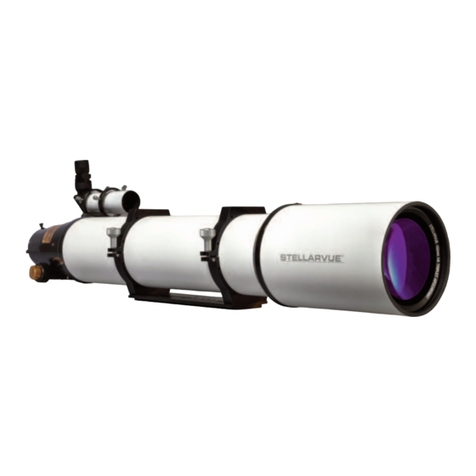
Stellarvue
Stellarvue SVX152T PREMIER APO TRIPLET User manual
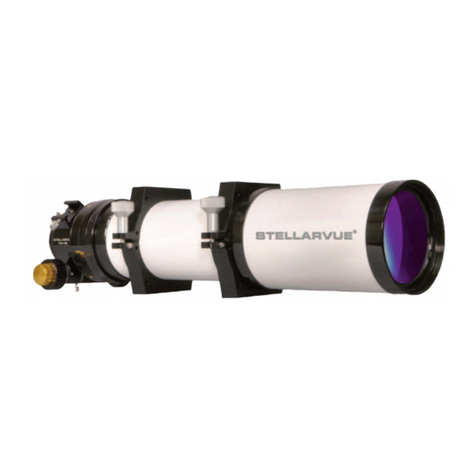
Stellarvue
Stellarvue SVX102T User manual
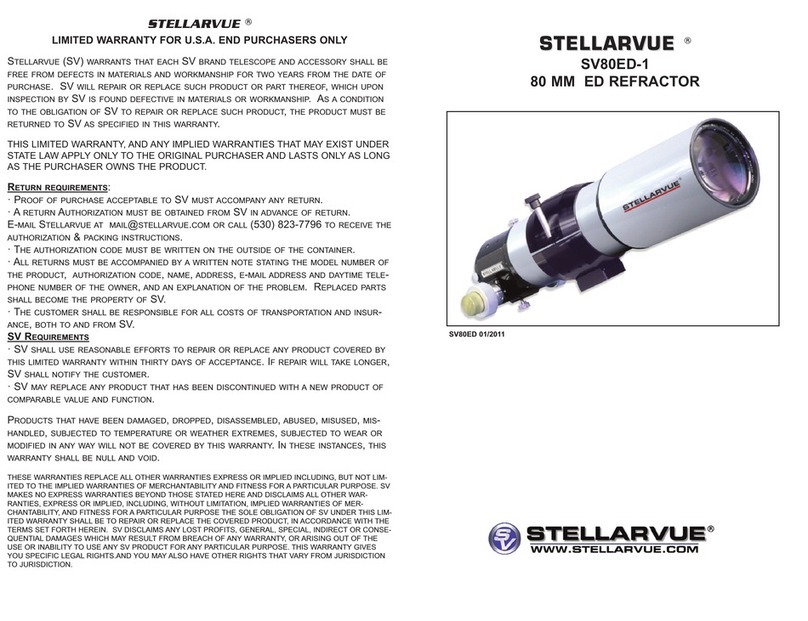
Stellarvue
Stellarvue SV80ED-1 User manual
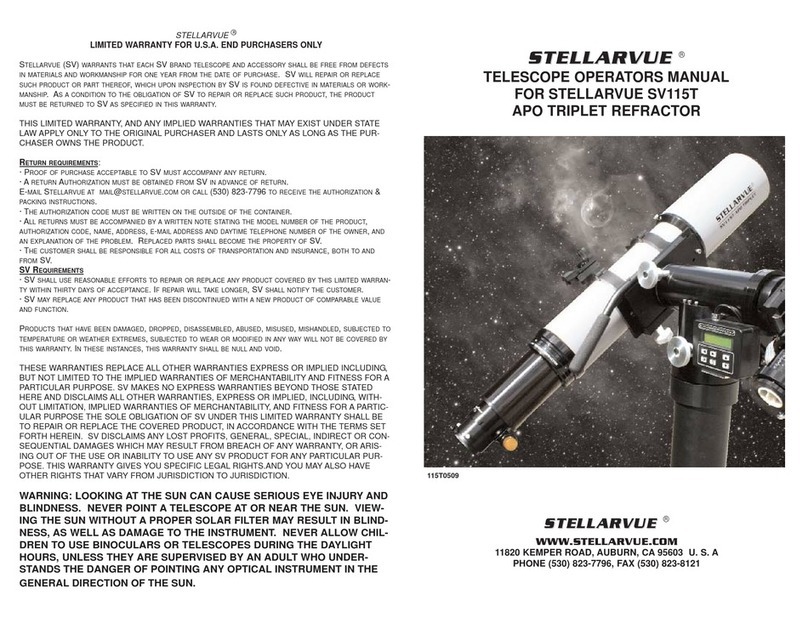
Stellarvue
Stellarvue SV115T User manual
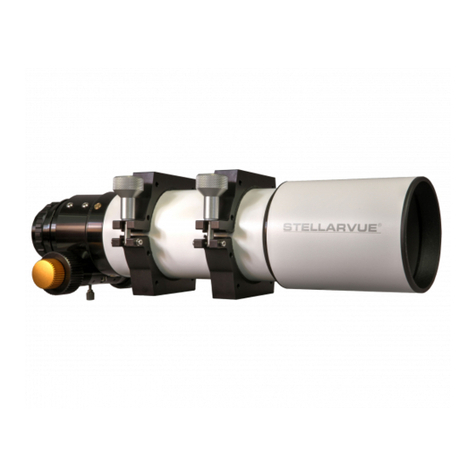
Stellarvue
Stellarvue SVX80T-25SV APO TRIPLET User manual
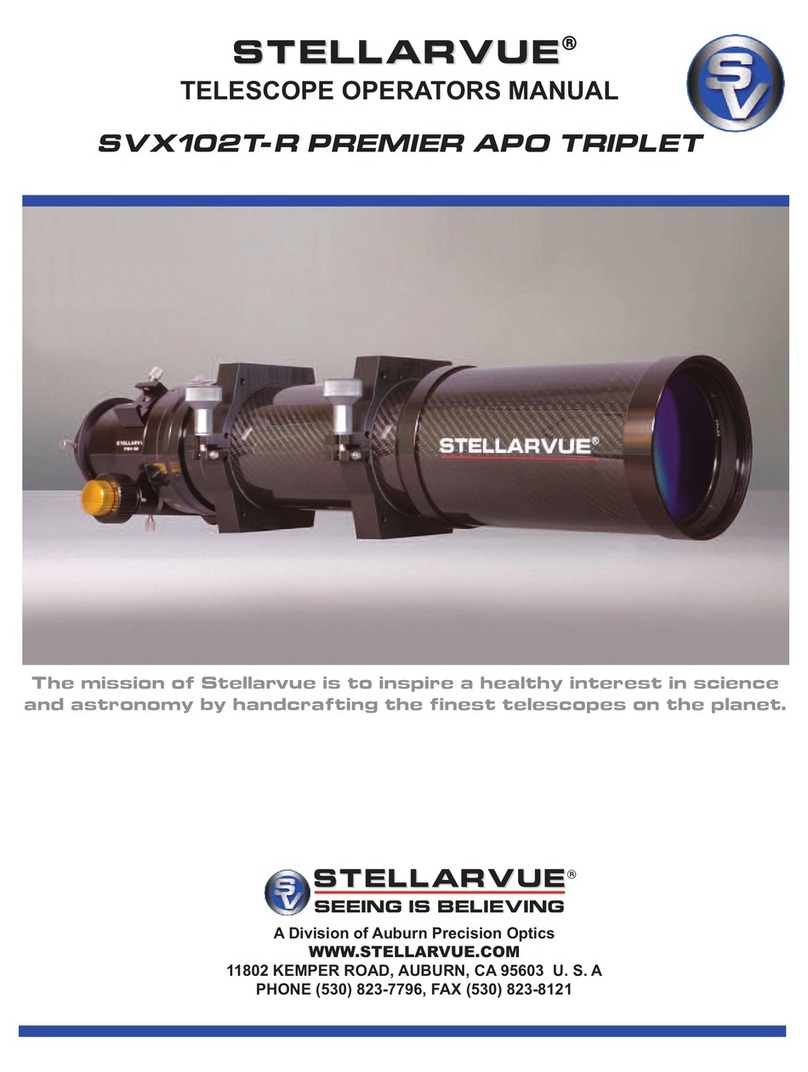
Stellarvue
Stellarvue SVX102T-R PREMIER APO TRIPLET User manual
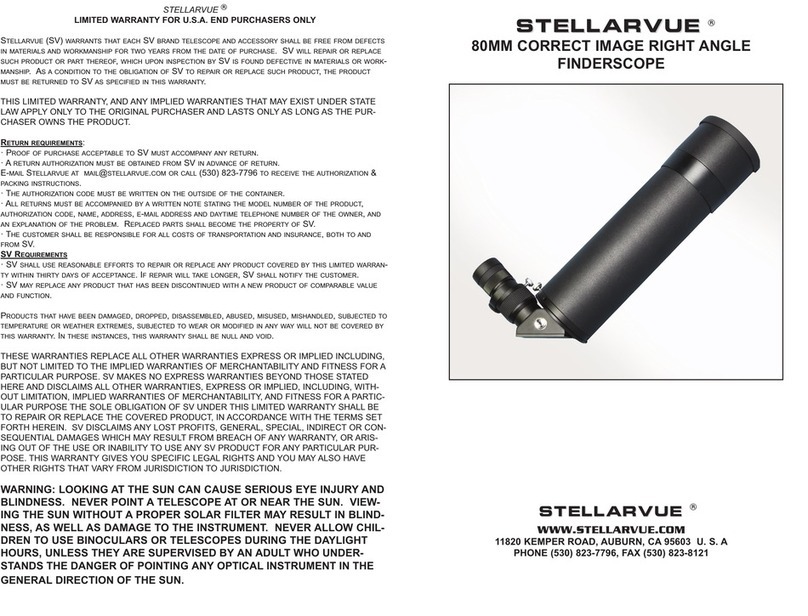
Stellarvue
Stellarvue F80 Series User manual
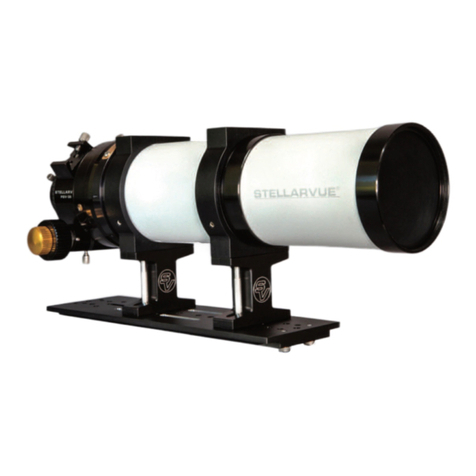
Stellarvue
Stellarvue PREMIER SVX80T-3SV User manual
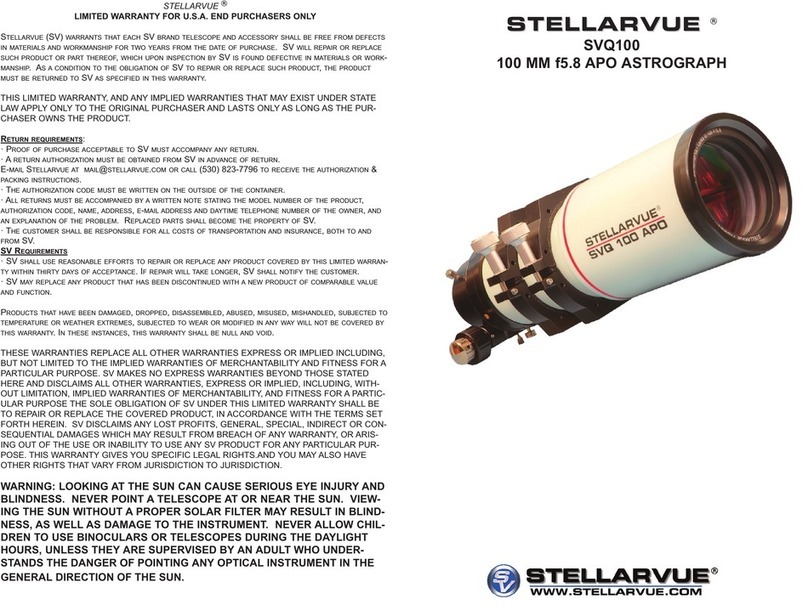
Stellarvue
Stellarvue SVQ100 User manual
